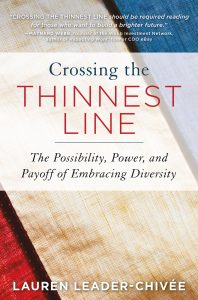”CROSSING THE THINNEST LINE” ~A what we as a country have to gain from embracing the diversity
By Terri Schlichenmeyer
Your business is doing well. It could do better.
Just like every other business in America , you have good weeks and bad. Sales go up and they flatten. You have financial feast-or-famine and you’d like more of the former than the latter. Author Lauren Leader-Chivée says she knows how you can achieve that and in “Crossing the Thinnest Line,” she explains.
Open the door to your office and look around. What does your staff look like? Many managers, as Leader-Chivée learned at a conference, tend to surround themselves with people who look like them. That might feel most comfortable, she indicates, but to do so is to miss out.
While some may find it awkward to actively, purposefully seek diversity, Leader-Chivée says it’s important to remember that most of us have ancestors who were outsiders once. It’s also rare in today’s world for anyone to live in a bubble: you probably already know, are related to, or come in regular contact with someone who is different than you, and you think nothing of it – which is to say that while humans generally resist change, you may already have “acquired diversity.”
Many folks find acquired diversity through family relationships and personal discoveries. Others simply jump in and get to know people who don’t look like them.
Insisting on diversity in the workplace not only “sparks creativity,” but it’s also forward-thinking: within the next 25-to-30 years, the U.S. will “become a majority-minority.” Diversity makes it easier to tap into new markets with impressive buying power, it allows your company to gain a foothold on other continents, and it will help to avoid the embarrassment of miscommunication. By utilizing new experiences from divergent people, you and your employees will benefit from a fresh point-of-view, taking “full advantage of… talents, insights, and creative energies” and a much larger scope of knowledge.
Without diversity, says Leader-Chivée, “we’ll suffer as a nation…”
“It’s a mistake we can’t afford to make.”
I cannot deny that what’s inside “Crossing the Thinnest Line” could be helpful. It’s filled with statistics, surprising solutions, and illustrative stories that show what world leaders and Big Business are doing. But that richness of info can also be a downfall: there’s just too much to take in here.
I really found myself wishing that author Lauren Leader-Chivée had made this into two books, or even three; that might have eased the overwhelmed feeling. As it is, the needs for large corporations are covered well, but not so much those of small-business owners or Mom-and-Pops who are miles from the Fortune 500. Leaders looking to hire more women will need to trek through information on diversity in race, sexuality, and religion. Non-business-minded readers get a little of everything, and may lose interest long before finding what they really need.
This isn’t a bad book – it’s just too much of a book and reading it for its full benefit will take considerable time. If you’ve got that time, though, dive into “Crossing the Thinnest Line.” It may do your business well.





